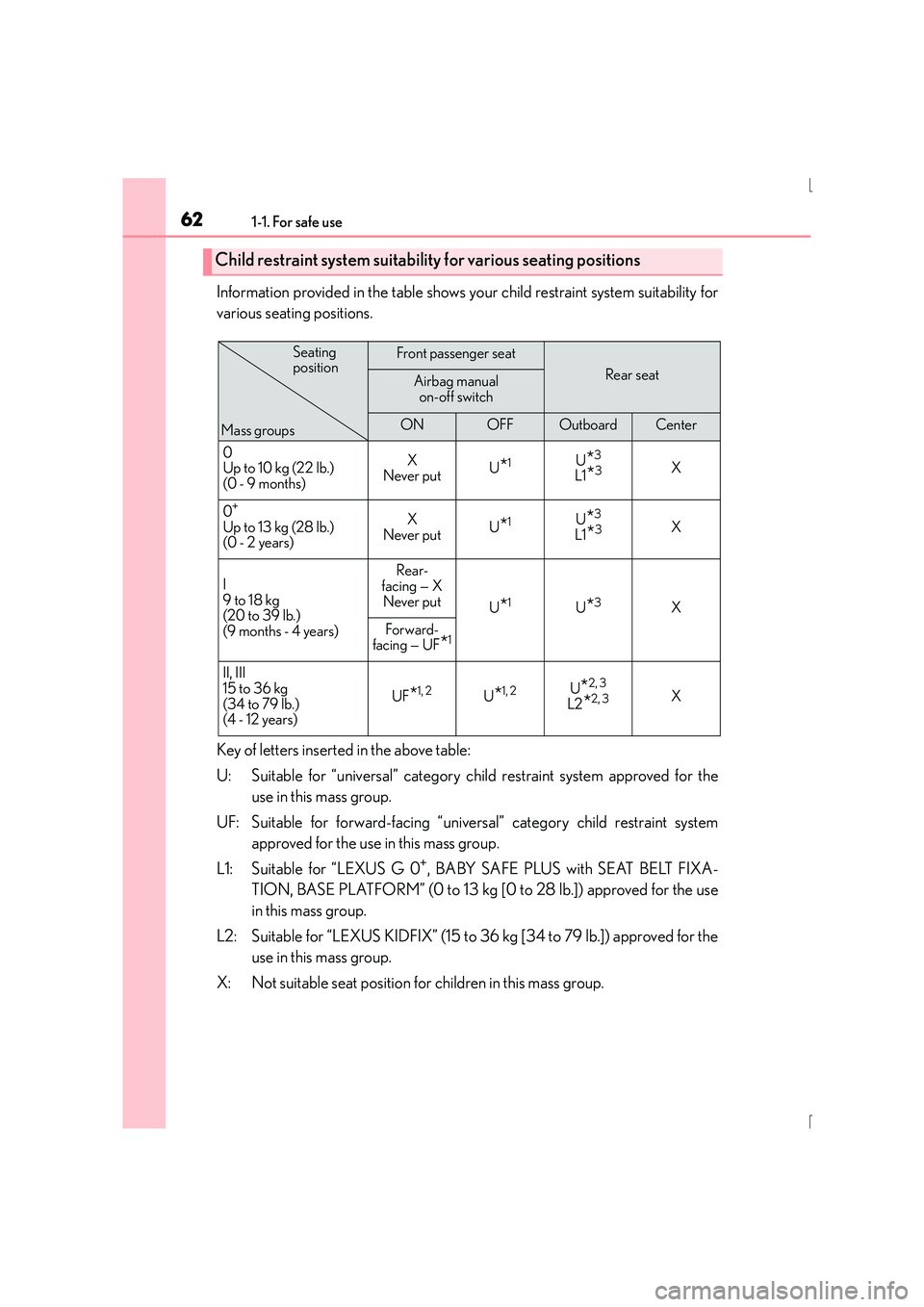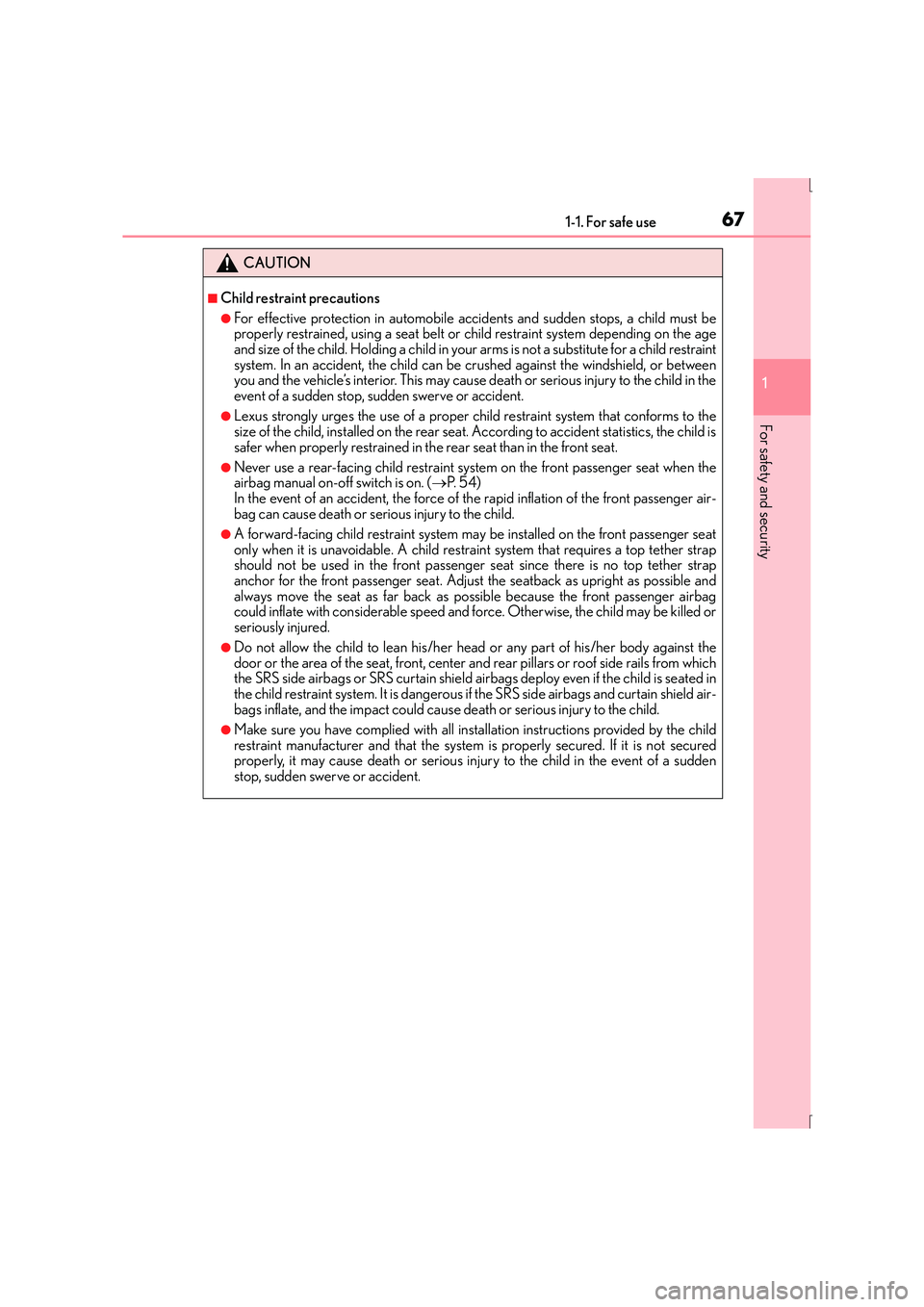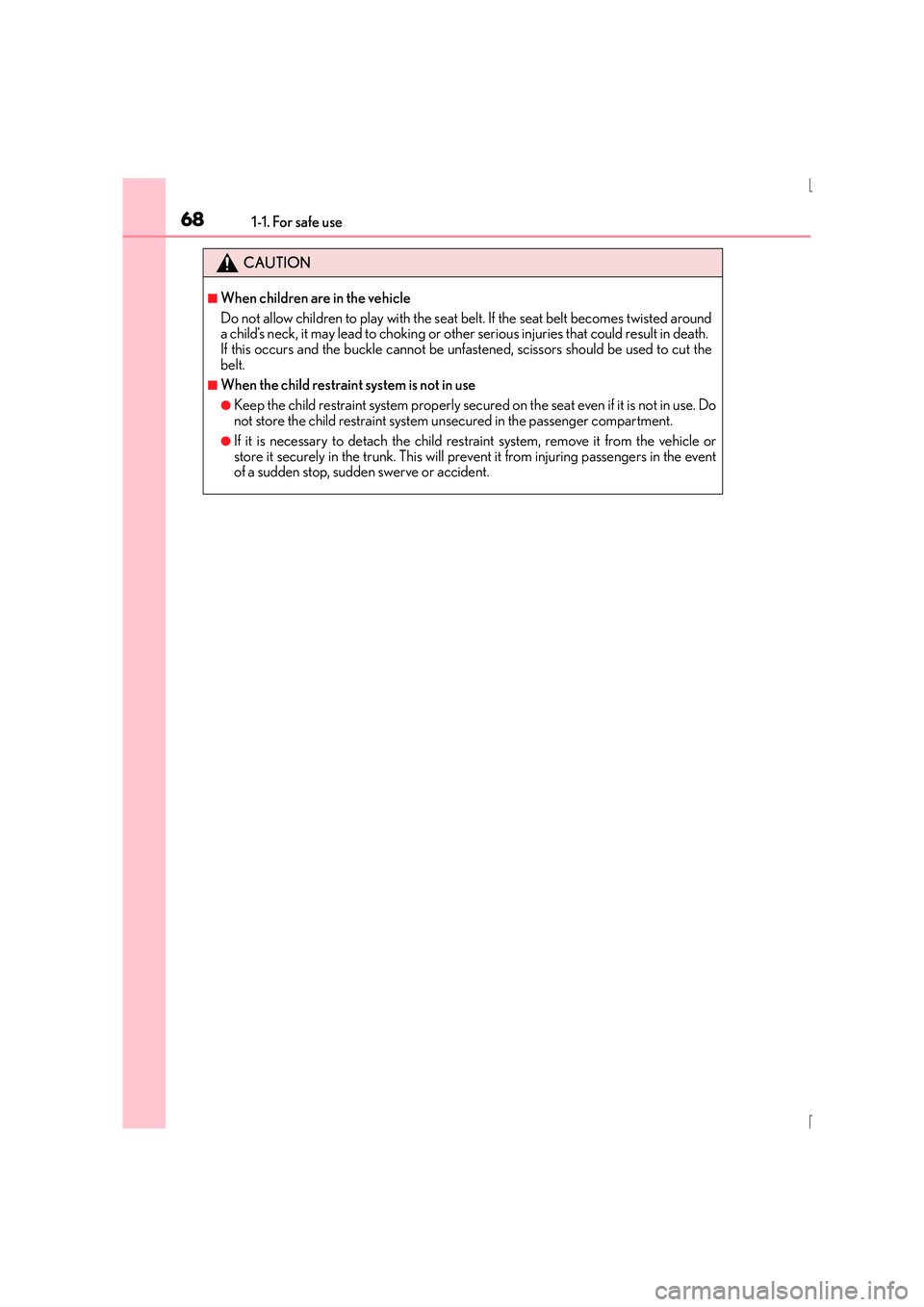Lexus IS300h 2015 Repair Manual
Manufacturer: LEXUS, Model Year: 2015, Model line: IS300h, Model: Lexus IS300h 2015Pages: 628, PDF Size: 137.89 MB
Page 61 of 628

611-1. For safe use
1
For safety and security
IS300h_EE(OM53D56E)
Child restraint systems are classified into the following 5 groups according to the
regulation ECE No.44:
Group 0: Up to 10 kg (22 lb.) (0 - 9 months)
Group 0
+: Up to 13 kg (28 lb.) (0 - 2 years)
Group I: 9 to 18 kg (20 to 39 lb.) (9 months - 4 years)
Group II: 15 to 25 kg (34 to 55 lb.) (4 years - 7 years)
Group III: 22 to 36 kg (49 to 79 lb.) (6 years - 12 years)
In this owner’s manual, the following 3 types of popular child restraint systems
that can be secured with the seat belts are explained:
Types of child restraints
�XBaby seat �XChild seat
Equal to Group 0 and 0
+ of ECE
No.44 Equal to Group 0+ and I of ECE
No.44
�XJunior seat
Equal to Group II and III of ECE No.44
Page 62 of 628

621-1. For safe use
IS300h_EE(OM53D56E)
Information provided in the table shows your child restraint system suitability for
various seating positions.
Key of letters inserted in the above table:
U: Suitable for “universal” category child restraint system approved for theuse in this mass group.
UF: Suitable for forward-facing “universal” category child restraint system approved for the use in this mass group.
L1: Suitable for “LEXUS G 0
+, BABY SAFE PLUS with SEAT BELT FIXA-
TION, BASE PLATFORM” (0 to 13 kg [0 to 28 lb.]) approved for the use
in this mass group.
L2: Suitable for “LEXUS KIDFIX” (15 to 36 kg [34 to 79 lb.]) approved for the use in this mass group.
X: Not suitable seat position for children in this mass group.
Child restraint system suitability for various seating positions
Front passenger seat
Rear seatAirbag manual on-off switch
ONOFFOutboardCenter
0
Up to 10 kg (22 lb.)
(0 - 9 months) X
Never put U
*1U*3
L1*3X
0
+
Up to 13 kg (28 lb.)
(0 - 2 years) X
Never put U*1U*3
L1*3X
I
9 to 18 kg
(20 to 39 lb.)
(9 months - 4 years) Rear-
facing — X Never put U
*1U*3X
Forward-
facing — UF
*1
II, III
15 to 36 kg
(34 to 79 lb.)
(4 - 12 years) UF
*1, 2U*1, 2U*2, 3
L2*2, 3X
Mass groups
Seating
position
Page 63 of 628

631-1. For safe use
1
For safety and security
IS300h_EE(OM53D56E)NOTE:
*1: Adjust the front seatback to the most upright position. Move the front seat cushion to
the fully rearward.
Adjust the seat cushion to the highest position. When the child restraint system
touched the ceiling, lower the seat position.
Follow these procedures• For installing a baby seat with support base
If the baby seat interferes with the seatback when latching the baby seat into the
support base, adjust the seatback rearward until there is no interference.
• For installing a forw ard-facing child seat
If there is gap between the child seat and the seatback, tilt the seatback rearward
until good contact is achieved.
If the seatbelt shoulder anchor is ahead of the child seat belt guide, move the seat
cushion forward.
• For installing a junior seat
If the child in your child rest raint system is in a very upright position, adjust the seat-
back to the most comfortable position.
If the seat belt shoulder anchor is ahead of the child seat belt guide, move the seat
cushion forward.
*2: Remove the head restraint if it interf eres with your child restraint system.
*3: When using the left side seat for the child re straint system, do not sit in the center seat.
The child restraint system mentioned in the table may not be available outside of
the EU area.
Other child restraint systems which are different from the systems mentioned in
the table can be used, but the suitability of the systems must be carefully checked
with the child restraint system manufacturer and retailer.
Page 64 of 628

641-1. For safe use
IS300h_EE(OM53D56E)
Information provided in the table shows your child restraint system suitability for
various seating positions.
Child restraint system suitability for various seating positions
(with ISOFIX rigid anchors)
Mass groupsSize
classFixture
Ve h i c l e I S O F I X positionsRecommended Child Restraint Systems
Rear outboard
Carrycot FISO/L1
X-
GISO/L2
X-
(1)
X-
Group 0
Up to 10 kg
(22 lb.) EISO/R1
IL*“LEXUS MINI”,
“LEXUS MIDI”
(1)
X-
Group 0+
Up to 13 kg
(28 lb.) EISO/R1
IL*
“LEXUS MINI”,
“LEXUS MIDI”
DISO/R2IL*
CISO/R3IL*
(1)X-
Group I
9 to 18 kg
(20 to 39 lb.) DISO/R2
IL*-
CISO/R3IL*
BISO/F2IUF*, IL*
“LEXUS MIDI”,
“LEXUS DUO+”
B1 ISO/F2XIUF*, IL*
AISO/F3IUF*, IL*
(1)X-
Page 65 of 628

651-1. For safe use
1
For safety and security
IS300h_EE(OM53D56E)
(1) For the child restraint system which do not carry the ISO/XX size classidentification (A to G), for the applicable mass group, the car manufacturer
shall indicate the vehicle specific ISOFIX child restraint system(s) recom-
mended for each position.
Key of letters inserted in the above table:
IUF: Suitable for ISOFIX forward-facing child restraint systems of universal cat- egory approved for use in this mass group.
IL: Suitable for ISOFIX child restraint systems of the categories for “specific vehicles”, “restricted”, or “semi-universal”, approved for use in this mass
group.
X: ISOFIX position not suitable for ISOFIX child restraint systems in this mass group and/or this size class.
*: Remove the head restraint if it interferes with your child restraint system. Do not sit onrear center seat when child restraint sy stem is installed to rear left seat.
When using a “LEXUS MINI” or “LEXUS MIDI”, adjust the support leg and the
ISOFIX connectors as follows:
Lock the support leg where 4th hole
can be seen. (“LEXUS MIDI” rear-
facing, “LEXUS MINI”)
Lock the support leg where 6th hole
can be seen. (“LEXUS MIDI” for-
ward-facing only)
Lock the ISOFIX connectors where
numbers 4 and 5 can be seen.
The child restraint system mentioned in the table may not be available outside of
the EU area.
Other child restraint systems which are different from the systems mentioned in
the table can be used, but the suitability of the systems must be carefully checked
with the child restraint system manufacturer and retailer.
1
2
3
Page 66 of 628

661-1. For safe use
IS300h_EE(OM53D56E)
■When installing a child restraint system on the front passenger seat
■Selecting an appropriate child restraint system
●Use a child restraint system appropriate for the child until the child becomes large
enough to properly wear the vehicle’s seat belt.
●If the child is too large for a child restraint sy stem, sit the child on a rear seat and use the
vehicle’s seat belt. ( →P. 3 8 )
When you have to use a child restraint system
on the front passenger seat, adjust the following:
●The seatback to the most upright position
●The seat cushion to the highest position
●The seat cushion to the fully rearward position
CAUTION
■Using a child restraint system
The use of a child restraint system not suit
able for the vehicle may not properly secure
the infant or child. It may result in death or serious injury (in the event of sudden braking
or an accident).
Page 67 of 628

671-1. For safe use
1
For safety and security
IS300h_EE(OM53D56E)
CAUTION
■Child restraint precautions
●For effective protection in automobile accidents and sudden stops, a child must be
properly restrained, using a seat belt or child restraint system depending on the age
and size of the child. Holding a child in your arms is not a substitute for a child restraint
system. In an accident, the child can be crushed against the windshield, or between
you and the vehicle’s interior. This may cause death or serious injury to the child in the
event of a sudden stop, sudden swerve or accident.
●Lexus strongly urges the use of a proper ch ild restraint system that conforms to the
size of the child, installed on the rear seat. According to accident statistics, the child is
safer when properly restrained in th e rear seat than in the front seat.
●Never use a rear-facing child restraint system on the front passenger seat when the
airbag manual on-off switch is on. (→P. 5 4 )
In the event of an accident, the force of the rapid inflation of the front passenger air-
bag can cause death or serious injury to the child.
●A forward-facing child restraint system may be installed on the front passenger seat
only when it is unavoidable. A child restra int system that requires a top tether strap
should not be used in the front passenger seat since there is no top tether strap
anchor for the front passenger seat. Adjust the seatback as upright as possible and
always move the seat as far back as possible because the front passenger airbag
could inflate with considerable speed and fo rce. Otherwise, the child may be killed or
seriously injured.
●Do not allow the child to lean his/her head or any part of his/her body against the
door or the area of the seat, front, center and rear pillars or roof side rails from which
the SRS side airbags or SRS curtain shield ai rbags deploy even if the child is seated in
the child restraint system. It is dangerous if the SRS side airbags and curtain shield air-
bags inflate, and the impact could caus e death or serious injury to the child.
●Make sure you have complied with all installation instructions provided by the child
restraint manufacturer and that the system is properly secured. If it is not secured
properly, it may cause death or serious inju ry to the child in the event of a sudden
stop, sudden swerve or accident.
Page 68 of 628

681-1. For safe use
IS300h_EE(OM53D56E)
CAUTION
■When children are in the vehicle
Do not allow children to play with the seat belt. If the seat belt becomes twisted around
a child’s neck, it may lead to choking or other serious injuries that could result in death.
If this occurs and the buckle cannot be unfastened, scissors should be used to cut the
belt.
■When the child restraint system is not in use
●Keep the child restraint system properly secure d on the seat even if it is not in use. Do
not store the child restraint system unsecured in the passenger compartment.
●If it is necessary to detach the child rest raint system, remove it from the vehicle or
store it securely in the trunk. This will prev ent it from injuring passengers in the event
of a sudden stop, sudden swerve or accident.
Page 69 of 628

691-1. For safe use
1
For safety and security
IS300h_EE(OM53D56E)
Seat belts (An ELR belt requires a lock-
ing clip)
ISOFIX rigid anchors
Lower anchors are provided for the out-
board rear seats, behind the anchor
covers.
Anchor brackets (for top strap)
An anchor bracket is provided for the
outboard rear seats.
Installing child restraints
Follow the child restraint system manufacturer’s instructions. Firmly secure
child restraints to the seats using a seat belt or ISOFIX rigid anchors. Attach
the top strap when installing a child restraint.
Page 70 of 628

701-1. For safe use
IS300h_EE(OM53D56E)
■Rear-facing Baby seat/child seat
Place the child restraint system
on the rear seat facing the rear of
the vehicle.
Run the seat belt through the
child restraint system and insert
the plate into the buckle. Make
sure that the belt is not twisted.
If your child restraint system is not
equipped with a lock-off (a seat belt
locking feature), secure the child
restraint system using a locking clip.
After installing the child restraint system, rock it back and forth to ensure that
it is installed securely.
Installing child restraints using a seat belt
1
2